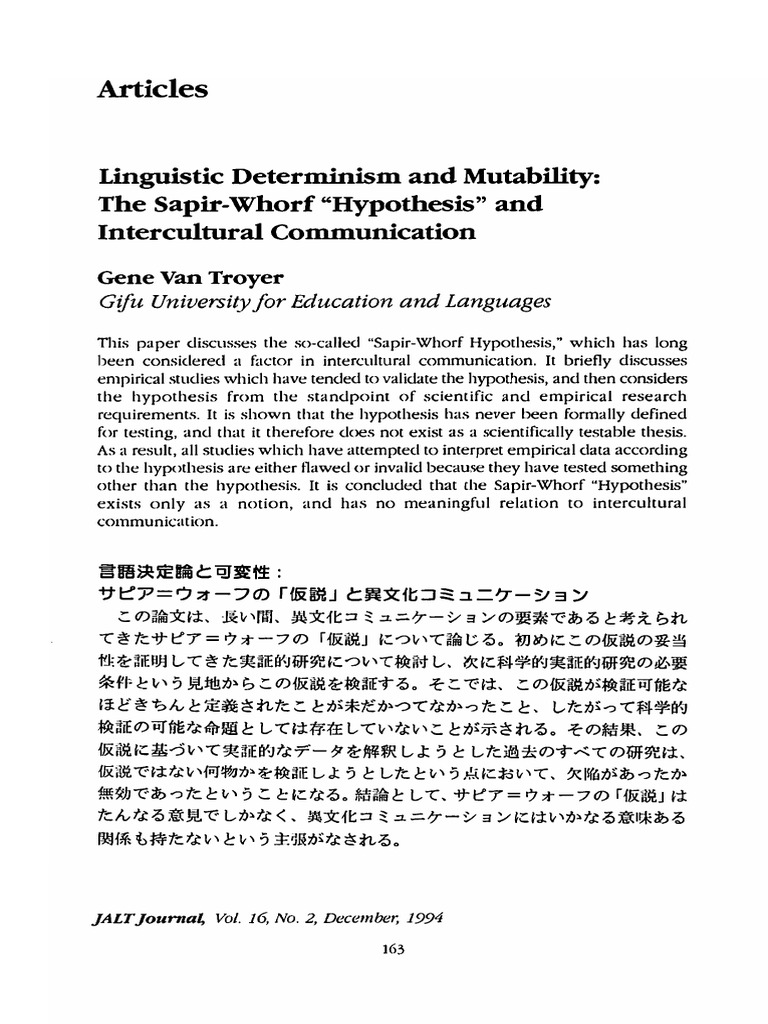The Sapir-Whorf hypothesis, often encapsulated in the terms linguistic determinism and linguistic relativism, presents a provocative lens through which to examine the intricate interplay between language and thought. It poses an intriguing question: does the language we speak significantly influence the way we perceive and understand the world around us? On one hand, linguistic determinism asserts that language shapes thought and constrains cognitive processes. On the other, linguistic relativism entertains the possibility that thought may not be as tightly bound by linguistic constructs as determinism suggests.
To embark on this exploration, one must first unravel the origins of the hypothesis. Edward Sapir and Benjamin Lee Whorf, early 20th-century linguists, proposed that the structure of a language influences its speakers’ worldview. Their investigations reached into diverse cultures, examining how their unique linguistic frameworks shaped their experiences and perceptions. For instance, Whorf’s study of the Hopi language revealed that it had no verb forms for the past or present, leading him to suggest that Hopi speakers conceive of time differently than speakers of languages with more linear temporal constructs.
This premise raises questions not just about language itself but about cognition and cultural identity. Can it be posited that speakers of different languages might fundamentally experience reality in divergent ways? To elucidate this, consider color perception. In some languages, distinct colors are fused into singular terms. For example, in Russian, the words for light blue (“голубой”) and dark blue (“синий”) are distinct. Research suggests that Russian speakers are quicker to discern differences in shades of blue compared to English speakers, where the color categories are more homogenized. Herein lies a playful challenge: if language shadows cognition in such a tangible way, how might our linguistic choices influence our reactions to pressing issues like climate change?
The implications of linguistic determinism extend beyond the realm of color and shape our environmental discourse. Language is powerful, framing the narratives we tell ourselves about the world. Take, for instance, the terminology employed in climate discussions. Words such as “climate crisis” versus “climate change” carry different connotations. The former evokes urgency and immediacy, whereas the latter can imply a gradual, less pressing evolution. This subtlety reflects not only linguistic choice but also sets the stage for potential action or inaction. How we characterize environmental degradation can influence public perception and policy responses significantly.
As we grapple with an urgent climate crisis characterized by rising seas, extreme weather events, and biodiversity loss, the relationship between language and thought becomes ever more poignant. The words used in climate activism can inspire collective agency or foster despondency. The Sapir-Whorf hypothesis posits that if our language colors our perception of the climate, can our approaches to activism also be constructed to harness language as a vehicle for transformation?
One could argue for a form of linguistic innovation in environmental activism. By crafting new terminologies or recontextualizing pre-existing ones, activists might cultivate a more resonant ecological consciousness. For instance, framing environmentalism as not just a personal choice but a communal responsibility might galvanize collective actions, transitioning from individualistic perspectives to those more attuned to kinship with the biosphere. This metamorphosis in lexicon could generate a more profound commitment from communities to combat climate change.
However, it is imperative to question the potential pitfalls of linguistic determinism in this context. If language predominantly determines thought and action, does it render those who lack access to liberating linguistic constructs powerless against the climate crisis? Not everyone speaks the same linguistic ‘toolset’; thus, does it follow that their capability to act is equally limited? In multicultural societies, this dynamic highlights urgent considerations regarding inclusivity in climate discourse. Different communities may possess unique knowledge systems, which, if not acknowledged, could stymie collaborative efforts against global warming.
Furthermore, as technology proliferates—particularly in the form of artificial intelligence and digital communication—our linguistic frameworks may become more standardized. The rise of global communication platforms often sidelines local dialects and vernaculars. Such homogenization could dilute the richness of diverse environmental vocabularies that have evolved to address specific regional ecological issues. Thus, while global mobilization is vital in combating climate change, it is equally essential to preserve and integrate localized knowledge and linguistic diversity.
In this multi-faceted scenario lies the potential for a renaissance in environmental advocacy. By incorporating varied linguistic perspectives and fostering multilingual dialogues, activists can enrich discussions about climate solutions. This landscape invites a reconsideration of the Sapir-Whorf hypothesis, suggesting that rather than a monolithic influence of language on thought, there exists a more nuanced, reciprocal relationship where linguistic diversity empowers varied cognitive engagements with environmental challenges.
Ultimately, as we confront the ramifications of climate change, the Sapir-Whorf hypothesis invites both introspection and exploration. It challenges us to examine not only the words we use but the thoughts we harbor and the actions we undertake. Are we merely shaped by our language, or can we redefine our narratives and thereby our experiences? The interplay between linguistic constructs and environmental awareness offers fertile ground for inquiry and, perhaps, the creative solutions necessary to navigate our unfolding ecological crisis.
